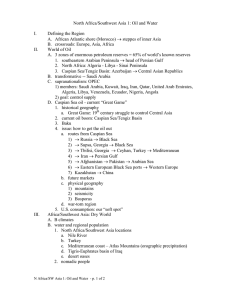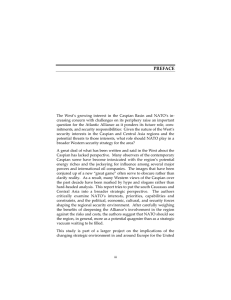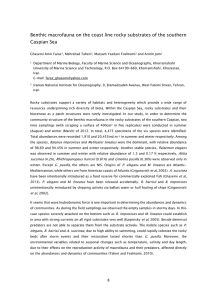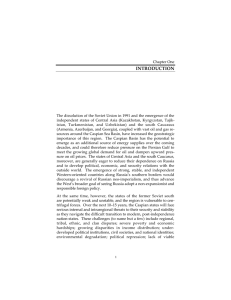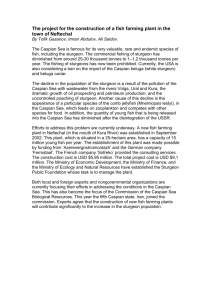Contourites in the Middle Caspian Sea?
advertisement
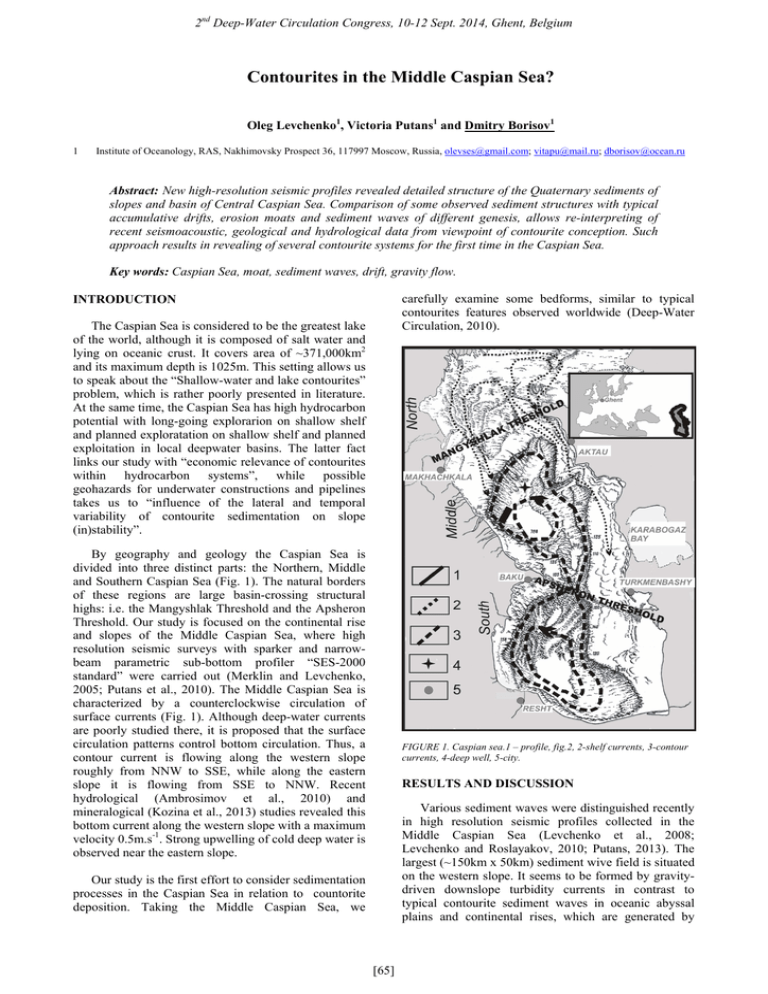
2nd Deep-Water Circulation Congress, 10-12 Sept. 2014, Ghent, Belgium Contourites in the Middle Caspian Sea? Oleg Levchenko1, Victoria Putans1 and Dmitry Borisov1 1 Institute of Oceanology, RAS, Nakhimovsky Prospect 36, 117997 Moscow, Russia, olevses@gmail.com; vitapu@mail.ru; dborisov@ocean.ru Abstract: New high-resolution seismic profiles revealed detailed structure of the Quaternary sediments of slopes and basin of Central Caspian Sea. Comparison of some observed sediment structures with typical accumulative drifts, erosion moats and sediment waves of different genesis, allows re-interpreting of recent seismoacoustic, geological and hydrological data from viewpoint of contourite conception. Such approach results in revealing of several contourite systems for the first time in the Caspian Sea. Key words: Caspian Sea, moat, sediment waves, drift, gravity flow. carefully examine some bedforms, similar to typical contourites features observed worldwide (Deep-Water Circulation, 2010). INTRODUCTION The Caspian Sea is considered to be the greatest lake of the world, although it is composed of salt water and lying on oceanic crust. It covers area of ~371,000km2 and its maximum depth is 1025m. This setting allows us to speak about the “Shallow-water and lake contourites” problem, which is rather poorly presented in literature. At the same time, the Caspian Sea has high hydrocarbon potential with long-going explorarion on shallow shelf and planned exploratation on shallow shelf and planned exploitation in local deepwater basins. The latter fact links our study with “economic relevance of contourites within hydrocarbon systems”, while possible geohazards for underwater constructions and pipelines takes us to “influence of the lateral and temporal variability of contourite sedimentation on slope (in)stability”. By geography and geology the Caspian Sea is divided into three distinct parts: the Northern, Middle and Southern Caspian Sea (Fig. 1). The natural borders of these regions are large basin-crossing structural highs: i.e. the Mangyshlak Threshold and the Apsheron Threshold. Our study is focused on the continental rise and slopes of the Middle Caspian Sea, where high resolution seismic surveys with sparker and narrowbeam parametric sub-bottom profiler “SES-2000 standard” were carried out (Merklin and Levchenko, 2005; Putans et al., 2010). The Middle Caspian Sea is characterized by a counterclockwise circulation of surface currents (Fig. 1). Although deep-water currents are poorly studied there, it is proposed that the surface circulation patterns control bottom circulation. Thus, a contour current is flowing along the western slope roughly from NNW to SSE, while along the eastern slope it is flowing from SSE to NNW. Recent hydrological (Ambrosimov et al., 2010) and mineralogical (Kozina et al., 2013) studies revealed this bottom current along the western slope with a maximum velocity 0.5m.s-1. Strong upwelling of cold deep water is observed near the eastern slope. FIGURE 1. Caspian sea.1 – profile, fig.2, 2-shelf currents, 3-contour currents, 4-deep well, 5-city. RESULTS AND DISCUSSION Various sediment waves were distinguished recently in high resolution seismic profiles collected in the Middle Caspian Sea (Levchenko et al., 2008; Levchenko and Roslayakov, 2010; Putans, 2013). The largest (~150km x 50km) sediment wive field is situated on the western slope. It seems to be formed by gravitydriven downslope turbidity currents in contrast to typical contourite sediment waves in oceanic abyssal plains and continental rises, which are generated by Our study is the first effort to consider sedimentation processes in the Caspian Sea in relation to countorite deposition. Taking the Middle Caspian Sea, we [65] 2nd Deep-Water Circulation Congress, 10-12 Sept. 2014, Ghent, Belgium future detailed studies (multibeam bathymetry and bottom currents measurements). along-slope flowing bottom currents (Deep-Water Circulation, 2010; Borisov, 2013). The sediment wave field terminates at the slope break towards the lower slope, of which the general morphology is similar to that of the contourite Ewing Terrace on the Argentina continental slope (Deep-Water Circulation, 2010). ACKNOWLEDGEMENTS This study was supported by the Project RFBR №14-05-00744. Distinctive depositional features with discordant inner reflectors and curved down basal reflectors occurs near the base of the western slope of the Middle Caspian Sea and two recent scours were revealed closer to the slope (Fig. 2). They likely represent contourite features drift and moats respectively (Deep-Water Circulation, 2010, Borisov, 2013). Presumably, these features, as well as the terrace above, were formed by a Coriolisdriven western branch of the alongslope current. REFERENCES Ambrosimov A.K., Ambrosimov E.C., Libina N.V., 2010. Dynamic structure of currents around western part depths of the Derbent Hollow of Caspian Sea. Engineering Physics, 10: 31-45. Borisov D.G., 2013. Contourites on the South American Continental Rise. PhD thesis, Institute of Oceanology, Moscow. Deep-Water Circulation: Processes & Products. 2010. International Congress, Baiona, Pontevedra, Spain, 16-18 June 2010. Geo-Teamas, 11, 204 p. Kozina N.V., Putans V.A., Zhdan M.I, 2013. Elaboration of sediment transport pathways by integrated interpretation of geological and highresolution seismoacoustic data (Caspian Sea). Dialogue between contourite and oceanology processes International Workshop. Hull, UK, p.34 Levchenko O.V., Roslyakov A.G., Polyakov A.S., Zverev A.S., Merklin L.R., 2008. New data about sedimentary waves on western continental slope of the Caspian Sea. Academy of Science Reports, 420: 537-542. Levchenko O.V., Roslyakov A.G., 2010. Cyclic sediment waves on western slope of the Caspian Sea as possible indicators of main transgressive/ regressive events. Quaternary International, 225: 210-220. Merklin L.R., Levchenko O.V., 2005. Sub-bottom profile of the Caspian Sea. Ocean Systems, 9: 11-15. Putans V.A., Merklin L.R., and Levchenko O.V., 2010. Sediment waves and other forms as evidence of geohazards in Caspian Sea. International Journal of Offshore and Polar Engineering, 20: 241-246. Putans V.A., 2013 Sediment waves: geohazard or geofeature? Hydro International Journal 10: 25-29. One of most spectacular features of the Middle Caspian Sea is a large system of channels/canyons near the Mangyshlak Threshold (overall Volga, Terek and Ural fan). Several fields of sediment waves on levees (Fig. 2) seem to be formed by the well-known mechanism of overspilling from underwater channels (Putans, 2013). Regular undulations occur on the eastern slope of the Middle Caspian Sea as well, but they have rather not sinuous but rectangular shape associated with postsedimentary plastic deformation, gravitational folds or creep (Levchenko and Roslayakov, 2010). However, taking in account strong bottom currents there and the similarity of these undulations with wavy structures on the Namibian continental slope interpreted as sedimentary waves (Deep-Water Circulation, 2010), possible distribution of contourites should be evaluated more careful. CONCLUSIONS Re-interpretation of recent high-resolution seismic profiles correlated with sediment cores reveals for the first time in the Caspian Sea several contourite systems with typical structures as drifts, moats, terraces and sediment waves. However, the detailed distribution pattern of these contourite systems is a question of FIGURE 2. Contourite drift beside foot of the western slope (above); sediment waves on channel levees near the Mangyshlak Threshold (below). [66]
